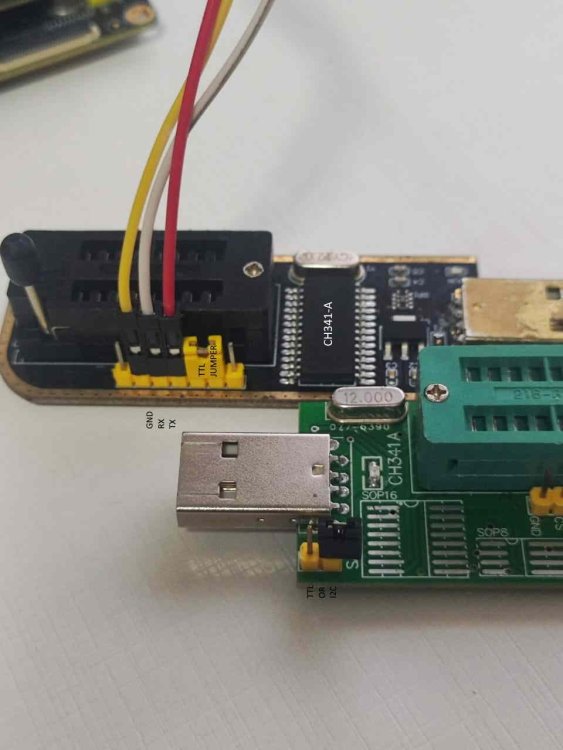Active threads
Showing topics posted in for the last 365 days.
- Today
-
I encountered the same issue using a custom v25.08 "RPi4b" image with kernel 6.12.37-current-bcm2711. I found out, that adding the following line to /boot/firmware/config.txt brings back the missing i2c device: However, this used to happen automatically with the old "RPi5" images.
-
https://paste.armbian.com/evuxesilum
-

Long Boot Delay on Banana Pi M5 in Headless Mode
gene1934 replied to alex_laco's topic in Banana Pi M5
These are usb3 labeled adapters, I did have problems earlier on a pi3b using another brand of adapter, but these startech adapters have been bulletproof, for years. c0rnelius current kernel is .6.12.22-current-meson64, will this patch apply? I've also found data on these drives indicating a 20W peak power for write operations. My present drive psu is a pretty hot usb wall wort, so based on 5x20, I have a 100W rated supply from amazon should be here midweek, and which will also power a 5" fan in one end of the drive cage. Which should move enough air to cool the drives. The question is now about the 7 port usb3 hub, can it deliver the 4 amps per port these drives need during a wright operatoin. Probably can't be answered until I can get a scope on the line. And that won't be done till the far end of the week. ;o}... If & when i get the psu i'll likely be back with more pix. Thanks until then. . . Cheers Gene. -
-
For Linux CP2102 doesn't work at 1.5 megabaud or 1500000 baud. for linux I discovered the CH341A I2C programmer. I just set it to TTL by a jumper and use it as 1.5 megabaud TTL UART 1500000 baud
-
@ER Samson To help figure out why your unit is stopping you could connect to it via an ssh session and as root run "journalctl -f". this might catch any error messages just prior to failure. When running with logs in zram, as Armbian does, the last messages in the logs are quite often lost when the system abruptly stops.
- Yesterday
-

Efforts to develop firmware for H96 MAX V56 RK3566 8G/64G
Hqnicolas replied to Hqnicolas's topic in Rockchip CPU Boxes
-
I bring the board up to use it on metal and Low level development, I use pci-e for jtag but I never considered the possibility of using an nvme there In my opinion, if you have a board that is running with internal emmc and sdcard you can provide an adjustment for pci-e NVME, It is a small adjustment, related to just one functionality of the board. I hope I'm not the only one with this board in my hands
-
Apparently I'm an idiot and did not fully read the instructions linked. I had not previously copied the files as per the instructions. Doing so allowed box64 to compile most of the way, and I then ran into the issue described here. I tried deleting the file as described and that did not help. I am unsure if my rpi zero 2w will work to compile it, but I shall post an update once I test that, then try copying the file over.
-
My switch correctly negotiates a 100mbps speed, and I also tried forcing it to 100mbps. In both cases, it links (LED on the switch is on and info from the switch says it is correctly negotiates 100mbps), and I see the TV box send a request for DHCP, and I see the answer from my DHCP server, but it stops there, I get no IP assigned in my interface. Setting a static IP on the interface also fails. I think I will start a new thread about this issue to better track this bug.
-
Hello Jock, thank you for all the work bringing this video acceleration to our boards. Can you give an updated comment about what to download or how to build Armbian OS, and get the needed requirements, before we apply the ffmpeg repository? I haven't been able to get video acceleration for many months. Can you tell us what new kernel modules are needed also?
-
vendor branch is based on latest rockchip bsp which is 6.1.115 atm. You can use code { font-family: Consolas,"courier new"; color: crimson; background-color: rgba(0, 0, 0, 0.2); padding: 2px; font-size: 105%; } armbian-config to switch.
- Last week
-

TX95 Max - Allwinner H618 Quadcore Cortex - A53
Guillaume lopéré replied to Mark Waples's topic in Allwinner CPU Boxes
Hello Mark, Sorry, I think I solved the problem by creating a readme file. Now you can create a fork of the github projet: https://github.com/GuillaumeLopere/Armbian-TX95Max-AllwinnerH618/fork - Then you can add documents with "+" and "Upload files" - "Choose your files" and Check the box "Create a new branch for this commit and start a pull request" I think this is the easiest way to do it. Best regards, Guillaume -

My experiece setting up an Orange Pi 5 Plus, current issues
blazini36 replied to blazini36's topic in Orange Pi 5 Plus
OK I've actually found the crux of the issue, though I haven't tried to figure out specifically what causes it yet. I ordered another Dumb TypeC->DP adapter cuz I figured there might be a bridge in my last one that was messing things up. It did the same thing with the messed up colors and shifted image. Then I remembered I have a typeC dock that's smart and has a DP port and it works fine. Checking Dmesg I noticed the dock sets up link training for 2 lanes @ 8.1Ghz. The dumb adapters with the bad color train 4 lanes at 2.7Ghz because that's what my display advertises. The Orange Pi5 Plus manual states: 1 x Type-C (DP 1.4A) output, up to 4K@60FPS To meet that bandwidth it needs to supply either 4 DP lanes @ HBR2 or 2 DP lanes @ HBR3. I reprogrammed My display's bridge (it's custom) to advertise only 2 DP lanes at 2.7Ghz. Now that's what the Opi does and the image is perfectly fine. So I think what happens here is the Orange Pi 5 may not actually have 4 lanes to supply over type C but it's configured so that it will try if requested. The 2 lanes of DP it can supply are incomplete as they are expecting to be merged with the other 2. When using a smart typeC dock, it intercepts the display's DPCD report and says "I only have 2 lanes at HBR3 so that's what I want". On a Type C dock with USB ports it's not possible to pull 4 lanes out of the host connection because the other 2 lanes have to be used for USB3.x. So basically the Opi has to be told the sink only has 2 lanes or it will screw up when it delivers 4 lanes and can't. I assume that's the correct assessment cuz I can plug this thing into any other PC with a real DP or type C alt and the color is fine, reporting 4 lanes over DPCD. I assume this is probably a device tree thing, I'll update the git issue on Opi's kernel repo, just figured it'd be good to let anyone trying to use it what might be going on. -
Hello, I have a MXQ Pro 5G 4K TV Box with Allwinner H616 and the motherboard IK316-EMCP_V4.1. I am looking for a server (CLI only) version of the Armbian image for this device. The previously shared Google Drive links in this topic are no longer working. Could someone please provide a new download link (Google Drive, MEGA, etc.) for the latest server image compatible with my device? If there are any specific instructions for booting or the correct DTB file, please let me know. Thank you very much! Best regards, Luska1331 BTW: I generated this message with the help of Copilot because I don't speak English very well.
-

Cubieboard 1 - No display output when booting Debian 12 image
Ryzer replied to Shakai2's topic in Allwinner sunxi
Difficult to say how to fix without further logs. What I am looking into and what it could possibly be related to is the simpledrm module loading alongside sun4i-drm. I wonder if you remove simpledrm then does the cursor become less erratic? Without diverging to far off topic, I suspect this related to sun4i-gpadc and how the temperature sensor is polled is carried out. The 6.12 Hdmi patches are a backport of the changes found in 6.15. -
Ok, maybe @jock has some suggestions to this issue.
-
Thanks for the hint Sirmalinton. Today, I could solve the problem. Here is a short summary that might be of use for people running into similar issues. Running lspci -k shows the "Non-Volatile memory controller" but it does not show the line "Kernel driver in use: nvme". Hence, I ran echo nvme > /sys/bus/pci/devices/0002\:01\:00.0/driver_override echo 0002:01:00.0 > /sys/bus/pci/drivers_probe where 0002:01:00.0 is from the output of lspci -k. That worked and made the disk appear as files /dev/nvme0*. To have a solution that works after reboot, I created a udev rule /etc/udev/rules.d/99-nvme-override.rules with the content: ACTION=="add", SUBSYSTEM=="pci", ATTR{vendor}=="0x144d", ATTR{device}=="0xa80d", ATTR{driver_override}="nvme" The vendor and device IDs are from lspci -nn. To trigger the probe, I created a systemd service /etc/systemd/system/nvme-rebind.service with the content: [Unit] Description=Rebind NVME controller to driver after override After=udev.service [Service] Type=oneshot ExecStart=/bin/sh -c "echo 0002:01:00.0 > /sys/bus/pci/drivers_probe" [Install] WantedBy=multi-user.target The service can be enabled via systemctl enable nvme-rebind.service. Maybe one reason it does not work in the first place is because /lib/systemd/system/nvmefc-boot-connections.service is not started. The reason is that the condition ConditionPathExists=/sys/class/fc/fc_udev_device/nvme_discovery is not met. Another reason, I can imagine is that the vendor/device ID combination is not registered to the nvme driver in the current kernel. As I mentioned before, it did work out of the box when I installed Armbian at first.
-
@Igor thank you for fixing overlay-prefix problem in current armbin-config now on OZPI V1 and V3 overlays in armbianEnv.txt are without prefix
-
It is now half a year later, this SD-card was put back into the RPi4 and no issues there. The RPi4 has been upgraded from Bookworm to Trixie in-place (just latest pre-release) so gets quite some writes. It still has Bookworm Btrfs snapshot as well, total of about 9GB excluding 2GB swap partition and 512MB bootFAT. Avarage Btrfs scrub speed 41MB/s. The ROCK3A has no SD-card inserted anymore, running fine, except that in the last 40 days I see: root@rock3a:~# uname -a Linux rock3a 6.1.115-vendor-rk35xx #1 SMP Fri May 30 01:18:17 UTC 2025 aarch64 GNU/Linux root@rock3a:~# dmesg | grep "page allocation failure:" [ 527.016616] dmcrypt_write/2: page allocation failure: order:0, mode:0x800(GFP_NOWAIT), nodemask=(null),cpuset=/,mems_allowed=0 [2879228.441453] dec0:0:hevc_rkm: page allocation failure: order:5, mode:0x40dc0(GFP_KERNEL|__GFP_COMP|__GFP_ZERO), nodemask=(null),cpuset=user.slice,mems_allowed=0 [2879523.127829] dec0:0:hevc_rkm: page allocation failure: order:5, mode:0x40dc0(GFP_KERNEL|__GFP_COMP|__GFP_ZERO), nodemask=(null),cpuset=user.slice,mems_allowed=0 [3029341.482298] kworker/0:1: page allocation failure: order:0, mode:0x800(GFP_NOWAIT), nodemask=(null),cpuset=/,mems_allowed=0 The middle 2 is clear what source is, the others I do not know. I think I will first upgrade userspace to Trixie. I currently have no clue what the details w.r.t. page faults mean, so have to see and figure out what issue could be or maybe mitigate somehow.
-
@JuanEsf Yep, here it is a080ed7128c898bec1cad6ec68c57bae159169d2fa06fb18008100ad63e4445c
-

Building Armbian Distribution with Kernel 6.10 for Orange Pi 5 Pro
C127 replied to Sergey Dulimov's topic in Rockchip
You are right, this is a strange DTS issue. U-Boot is working, but the kernel can't initialize the SD card, which is why it drops to the initramfs shell. Unfortunately, I can't reproduce this specific error myself, but I agree with the analysis. I suspect this is the same reason why newer U-Boot versions initially failed to boot for me. I will start working on fixing the DTS next week. Thanks for finding this bug!







